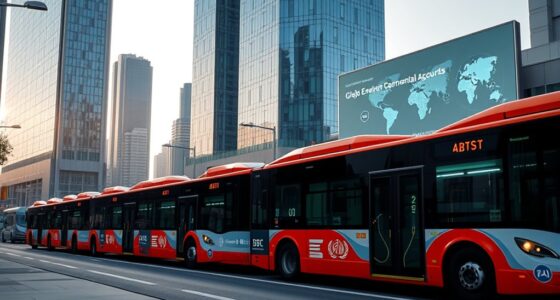You’ll see that the VW Bus has evolved from basic, style-focused design with minimal safety features to a vehicle built with crashworthiness in mind. Over time, stricter safety regulations pushed automakers to reinforce frames, add restraints, and incorporate advanced tech like airbags and ABS. These changes have made today’s models much safer for passengers. If you want to understand how these safety standards developed and their impact, keep exploring this important journey.
Key Takeaways
- Early VW Buses prioritized style and practicality, with minimal safety features and lax crash standards.
- Progressive safety regulations prompted structural reinforcements like crumple zones and reinforced doors.
- Over time, passenger protection features such as airbags and better restraints became standard.
- Adoption of advanced safety technologies like ABS and electronic stability control improved vehicle safety.
- Evolving regulations shifted VW Bus design from basic utility to comprehensive crashworthiness and collision prevention.

Safety regulations have evolved considerably over the years, reflecting advances in technology and a better understanding of workplace hazards. This evolution has directly impacted how vehicles like the VW Bus are designed, especially in terms of passenger protection and crash standards. When the VW Bus first hit the roads, safety wasn’t a primary concern. It was built for practicality and style, often sacrificing safety features that are now standard. Back then, crash standards were minimal, and passenger protection mainly relied on seat belts and basic structural integrity. As a result, early models offered limited safety, and occupants were vulnerable in accidents.
Early VW Buses prioritized style over safety, with minimal crash standards and basic passenger protection.
Over time, regulatory agencies recognized the need to improve these standards. Governments introduced stricter crash standards that required automakers to reinforce vehicle frames, implement better crumple zones, and improve overall structural integrity. These changes meant that newer VW Bus models, and other vehicles, could better absorb impact energy, reducing injury risks. Passenger protection became a focal point, leading to the inclusion of safety features like reinforced doors, better seating restraints, and, later, airbags. These advancements weren’t just about compliance; they aimed to genuinely protect passengers during collisions.
As safety regulations advanced, automakers also adopted innovative safety technologies. Anti-lock braking systems (ABS), electronic stability control, and crash avoidance systems became commonplace. For the VW Bus, which was initially designed with simplicity in mind, these features marked a significant shift. They contributed to safer driving experiences and helped meet evolving crash standards. Today’s vehicles are built with an extensive safety mindset, emphasizing not just crashworthiness but also collision prevention, further protecting passengers.
You can see this progression clearly in the changes to the VW Bus over the decades. Early models prioritized utility and style, with little regard for crash standards or passenger protection. Modern versions, if they exist, incorporate advanced safety features that weren’t even imaginable in the early days. The continuous tightening of safety regulations drives automakers to innovate constantly, making sure that passenger protection keeps pace with technological advancements. Ultimately, this evolution results in vehicles that are much safer for everyone on the road, reflecting a collective effort to minimize injuries and fatalities. The journey from the original VW Bus to today’s modern safety standards exemplifies how safety regulations shape vehicle design, ensuring that passenger protection and crash standards are at the forefront of automotive development.
Frequently Asked Questions
How Did Safety Regulations Impact the Design of Early VW Buses?
You notice how early VW buses changed over time, and safety regulations played a big role. They pushed for features like airbag integration and stricter crash test protocols, which led to design improvements. You can see the upgrades in structural integrity and safety features, ensuring passengers are better protected. These regulations directly influenced the bus’s evolution, making it safer while maintaining its iconic style.
What Specific Safety Features Were Added in Later VW Bus Models?
You’ll notice later VW bus models added safety features like seat belts and crash zones to protect you better. Seat belts became standard, reducing injury risks, while crash zones absorbed impact during collisions, safeguarding passengers. These updates made your driving experience safer by addressing previous vulnerabilities. As technology advanced, VW continually improved the bus’s safety, ensuring you and your loved ones travel with greater confidence and security.
How Do Current Safety Standards Differ Globally for Vehicles Like the VW Bus?
Global safety standards differ markedly today. You’ll notice stricter airbag requirements and more rigorous crash test standards worldwide. Countries prioritize passenger protection, pushing manufacturers to meet evolving regulations. You’re impacted by these differences through safer, more secure vehicles. As standards tighten, vehicles like the VW Bus adapt by integrating advanced safety features to comply, ensuring your journey is safer wherever you go.
Were There Any Safety Incidents That Prompted Regulatory Changes for VW Buses?
You might wonder if any safety incidents led to changes in VW Bus regulations. Indeed, passenger safety concerns and regulatory history prompted manufacturers to improve features like seat belts and crash protection. These incidents raised awareness, pushing authorities to implement stricter standards. As a result, VW evolved its buses over time, enhancing safety to better protect passengers and comply with evolving safety regulations worldwide.
How Does Safety Regulation Evolution Influence Modern Vehicle Design Beyond VW Buses?
Imagine sleek cars gliding through streets, their design shaped by safety regulation evolution. You see seat belt mandates and crash test protocols guiding engineers to prioritize passenger protection. These standards push modern vehicle design to incorporate advanced safety features like airbags and collision avoidance systems. You benefit from safer rides, as automakers innovate to meet stricter requirements, making every journey more secure than ever before.
Conclusion
As you reflect on the evolution of the VW bus, it’s clear how safety standards have transformed from simple guidelines to essential protections. Just as the bus itself has journeyed through time, so too has our commitment to safety grown stronger. Remember, progress isn’t just about technology; it’s about caring for each other. Like a trusty compass, safety regulations guide us toward a future where everyone rides with confidence and peace of mind.









